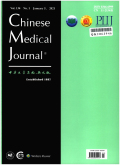Pulmonary endarterectomy for chronic thromboembolic pulmonary hypertension: preliminary exploration in China
摘要Background Pulmonary endarterectomy is safe and effective surgical treatment for chronic thromboembolic pulmonary hypertension. This study aimed to evaluate the efficacy of pulmonary endarterectomy in treatment of thromboembolic pulmonary hypertension.Methods A retrospective study of 15 patients who underwent pulmonary endarterectomy in Beijing Chaoyang Hospital was performed. Obvious pulmonary hypertension and hypoxemia were observed in all patients. Bilateral pulmonary endarterectomy was performed under cardiopulmonary bypass with profound hypothermic circulatory arrest. Results Two patients (2/15) died of residual postoperative pulmonary hypertension and bleeding complication. The other 13 cases had significant decrease in systolic pulmonary artery pressure ((92.8±27.4) mmHg vs. (49.3±18.6) mmHg) and pulmonary vascular resistance ((938.7±464.1) dynesscm~(-5) vs. (316.8±153.3) dynes-s-cm~(-5)), great improvement in cardiac index ((2.31 ±0.69) L·min~(-1)·m~(-2) vs. (3.85±1.21) L·min~(-1)·m~(-2)), arterial oxygen saturation (0.67±0.11 vs. 0.96±0.22) and mixed venous O_2 saturation (0.52±0.12 vs. 0.74±0.16) postoperatively compared to preoperative data. Mid-term follow-up showed that the cardiac function of all cases returned to NYHA class Ⅰ or Ⅱ, with great improvement in 6-minute walking distance ((138±36) m) and quality of life.Conclusions Bilateral pulmonary endarterectomy using cardiopulmonary bypass with the aid of deep hypothermia and circulatory arrest can effectively reduce pulmonary hypertension and provide good mid-term hemodynamic and symptomatic results with low surgical mortality rate and few complications.
更多相关知识
- 浏览108
- 被引5
- 下载12


相似文献
- 中文期刊
- 外文期刊
- 学位论文
- 会议论文



 换一批
换一批 换一批
换一批



